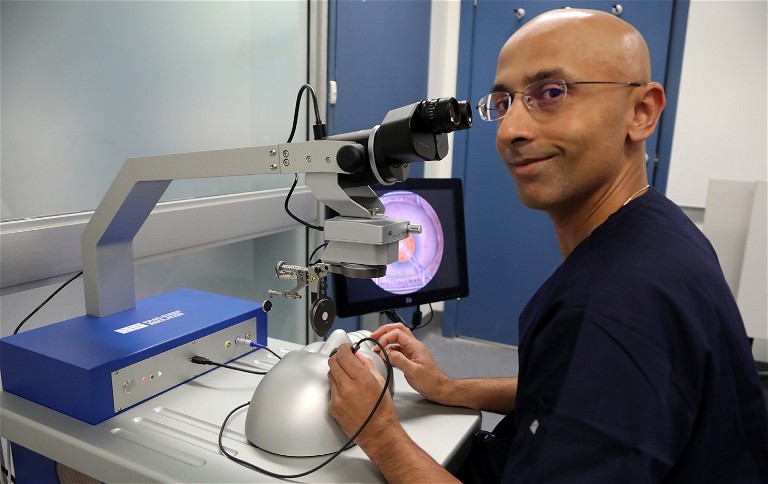minews
New Surgery Training Simulator for Western Sydney
Westmead Hospital has become home to the latest ophthalmic surgical training technology with the installation of an EyeSi cataract surgery simulator – the first of its kind outside the major training hubs of Prince of Wales Hospital and Sydney Eye Hospital in Sydney’s eastern suburbs.
The AU$300,000 virtual reality simulator allows trainee ophthalmologists to practise the intricate skills required for cataract and vitreoretinal surgery before operating on live patients.
“The idea for training with the EyeSi surgical simulator was initiated by the Royal Australian and New Zealand College of Ophthalmology (RANZCO), and it is now expected that before surgical trainees can do live cataract surgery, they pass at least three of the EyeSi’s modules,” explained Clinical Associate Professor Andrew White, a clinician scientist ophthalmologist at Westmead Hospital.
“It’s a VR simulator – a little plastic head with cataract type instruments and a microscope. But when you look down the microscope, there’s different training modules to teach skills like hand-eye coordination and depth perception.”
The simulator, produced by Haag Streit, is networked to allow trainee progression through the modules to be tracked, even as they rotate through different hospitals every few months.
“Now these things are about $300,000 a piece, so they’re not cheap,” Prof White explained to mivision. “And they’re networked so wherever you go, your progress goes into the cloud so you can get ticked off on your training.”
Until now, Sydney Eye Hospital and Prince of Wales Hospital in Sydney had the only EyeSi simulators in New South Wales, leaving many trainees in Western Sydney, and other areas of the state, unable to easily access this crucial pre-surgery training.
And this has meant that “for a lot of the junior trainees, it hasn’t been feasible to complete their early simulator training within the first three to six months as required”, Prof White said.
Even at Westmead Hospital, the second biggest ophthalmic training centre in Sydney with six ophthalmology registrars at any time, he said the demands of patient care often means there is no time for them to travel across town for training. For smaller hospitals, where the registrar can be the only ophthalmologist on site, the opportunities to leave for training are even fewer.
“Some junior trainees were essentially getting benched because they couldn’t get the prerequisite simulator training… Having the EyeSi at Westmead will really help get them surgery-ready sooner.”
He said the lack of local training opportunities was also deterring young ophthalmologists from considering future work in Western Sydney.
“If you don’t have access to a good training experience outside the eastern suburbs, you’re less likely to want to set up a practice in those local areas,” Prof White said.
Westmead’s new simulator will service trainees from Westmead, Blacktown, Mount Druitt, Auburn, and other Western Sydney hospitals. It contains modules specifically for cataract and retinal surgery training.
The simulator will also allow qualified ophthalmologists to brush up on their skills if needed.
Installation of further simulators is planned for Liverpool/Campbelltown and other areas to continue expanding decentralised training opportunities.
“Virtual reality and AI are the buzzwords now and this type of simulation is becoming an integral part of ophthalmic training,” Prof White said. “It’s great that Western Sydney can now be at the forefront.”
Acquisition and implementation of the EyeSi for Westmead Hospital was supported and funded by NSW RANZCO. Its procurement was also supported by a local team that included Drs Dana Robaei, Leanne Cheung, Nisha Sachdev, Raj Chalasani, and administrative manager Andy Bamford.

Westmead ophthalmologist Dr Raj Chalasani.